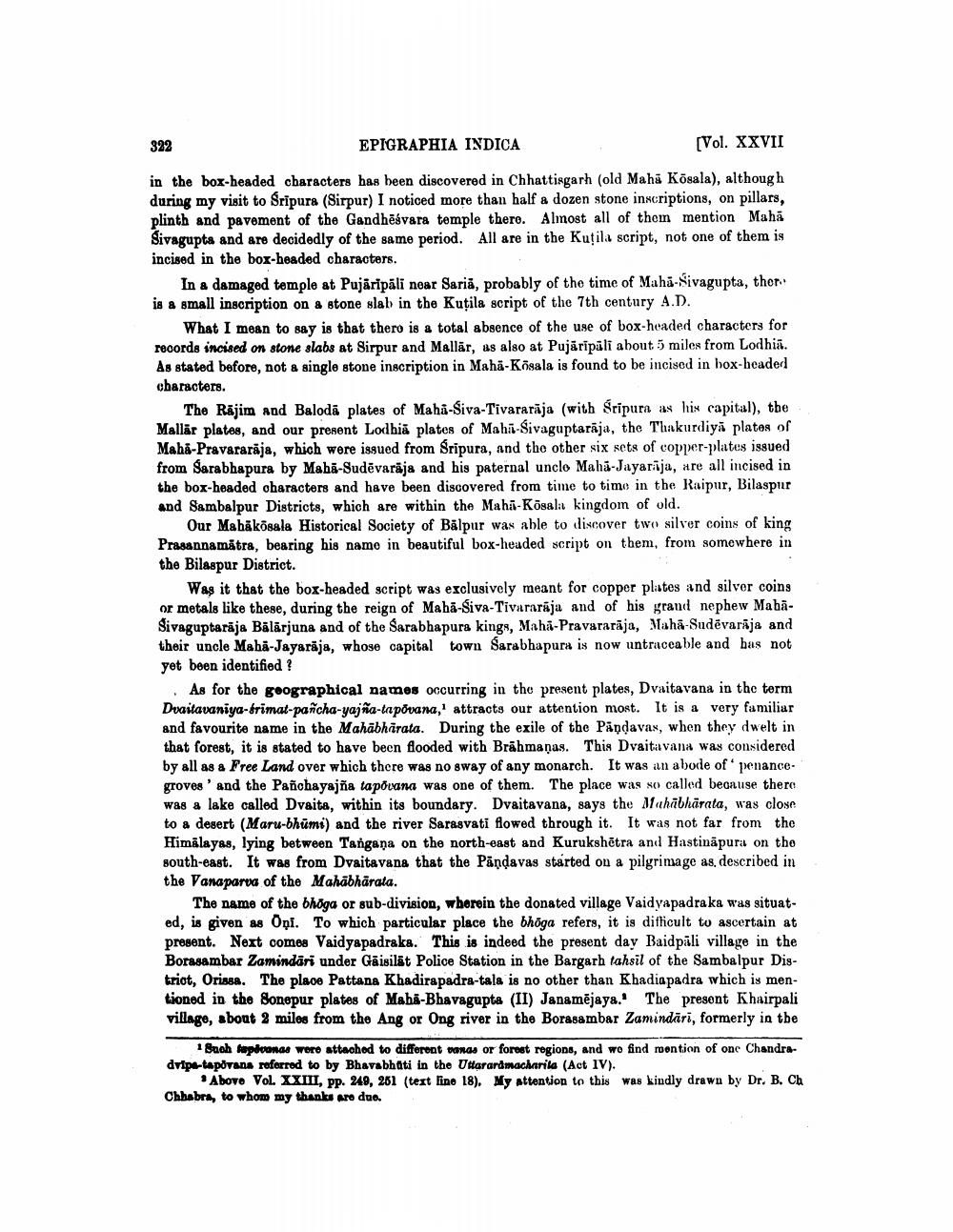________________
322
EPIGRAPHIA INDICA
[Vol. XXVII
in the box-headed characters has been discovered in Chhattisgarh (old Mahā Kösala), although during my visit to Sripura (Sirpur) I noticed more than half a dozen stone inscriptions, on pillars, plinth and pavement of the Gandhēsvara temple there. Almost all of them mention Mahā Sivagupta and are decidedly of the same period. All are in the Kutila script, not one of them is incised in the box-headed characters.
In a damaged temple at Pujäripali near Saria, probably of the time of Maha-Sivagupta, thor is a small inscription on a stone slab in the Kutila script of the 7th century A.D.
What I mean to say is that thero is a total absence of the use of box-headed characters for records incised on stone slabs at Sirpur and Mallar, as also at Pujāripūli about 5 miles from Lodhi.. As stated before, not a single stone inscription in Maha-Kõgala is found to be incised in box-headed characters.
The Räjim and Balodā plates of Maha-Siva-Tivararāja (with Sripurn as his capitul), the Mallär plates, and our present Lodhia plates of Mahi-Sivaguptarāja, the Thakurdiyā plates of Maha-Pravararāja, which were issued from Sripura, and the other six sets of copper-plates issued from Sarabhapura by Maha-Sudēvaraja and his paternal unclo Maha-Jayarīja, are all incised in the box-headed characters and have been discovered from time to time in the Raipur, Bilaspur and Sambalpur Districts, which are within the Maha-Kõsala kingdom of old.
Our Mahäkösala Historical Society of Bälpur was able to discover two silver coins of king Prasannamätra, bearing his namo in beautiful box-headed script on them, from somewhere in the Bilaspur District.
Was it that the box-headed script was exclusively meant for copper plates and silver coins or metals like these, during the reign of Maha-Siva-Tivararāju and of his grand nephew MabaSivaguptarāja Bālärjuna and of the Sarabhapura kings, Maha-Pravararāja, Maha-Sudēvarāja and their uncle Maba-Jayaraja, whose capital town Sarabhapura is now untraceable and has not yet been identified ?
. As for the goographical names occurring in the present plates, Dvaitavana in the term Dvaitavaniya-frimat-pancha-yajña-tapovana,' attracts our attention most. It is a very familiar and favourite name in the Mahabharata. During the exile of the Pandavax, when they dwelt in that forest, it is stated to have been flooded with Brahmaņas. This Dvaitavana was considered by all as a Free Land over which there was no sway of any monarch. It was an abode of 'penancegroves' and the Panchayajña tapovana was one of them. The place was so called because there was a lake called Dvaita, within its boundary. Dvaitavana, says the Mahabharata, was close to a desert (Maru-bhūmi) and the river Sarasvati flowed through it. It was not far from the Himalayas, lying between Tangana on the north-east and Kurukshētra and Hastinapura on the south-east. It was from Dvaitavana that the Pandavas started on a pilgrimage as, described in the Vanaparva of the Mahābhārata.
The name of the bhoga or sub-division, wherein the donated village Vaidyapadraka was situated, is given as Oņi. To which particular place the bhöga refers, it is difficult to ascertain at present. Next comes Vaidyapadraka. This is indeed the present day Baidpāli village in the Borasambar Zamindāri under Gäisilāt Police Station in the Bargarh tahsil of the Sambalpur Distriot, Orissa. The place Pattana Khadirapadra-tala is no other than Khadia padra which is mentioned in the Sonopur plates of Maha-Bhavagupta (II) Janamējaya.' The presont Khairpali village, about 2 miles from the Ang or Ong river in the Borasambar Zamindāri, formerly in the
Sneh tapiconas were attached to different tanas or forest regions, and we find moontion of one Chandradvipe-tapovans referred to by Bhavabhati in the Utarardmacharila (Act IV).
Above Vol XXIII, pp. 249, 261 (test fine 18). My attention to this was kindly drawn by Dr. B. Ch Chhabra, to whom my thanks aro duo.




